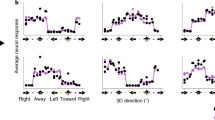Abstract
We introduce a dynamical model for automatic vergence eye movement control. In connection with our dynamical system of binocular model neurons that solves the correspondence problem of stereo-vision, we present a complete model for stereo-vision. Our automatic vergence eye movement control adjusts an image segment, which is of momentary interest to the observer. The adjustment is done in such a way that we only need to define a disparity search range of minimal extension. ecently, a new method of encoding (3D) three-dimenional information in 2D pictures was designed in the form of computer-generated patterns of colored dots. At first glimpse, these so-called autostereograms appear as structured but meaningless patterns. After a certain period of observation, a 3D pattern emerges suddenly in an impressive way. Applying our algorithm to autostereograms, we find a fully satisfactory agreement with the multivalent perception experienced by humans. As in nature, in our model the phase transition between the initial state and the 3D perception state takes place in a very short time. Our algorithm is very robust against noise, and there is no need to interpolate a sparse depth map.
Similar content being viewed by others
References
Barlow HB, Blakemore C, Pettigrew J (1967) The neural mechanism of binocular depth discrimination. J Physiol Lond 193:327–342
Barnard ST, Fischler MA (1982) Computational stereo. Comput Surv 14:553–572
Dhond UR, Aggarwal JK (1989) Structure from stereo — a review. IEEE Trans Syst Man Cybern 19:1489–1510
Frisby JP, Clatworthy JL (1975) Learning to see complex random-dot stereograms. Perception 8:173–178
Grimson WEL (1981) A computer implementation of a theory of human stereo vision. Phil Trans R Soc Lond [Biol] 292:217–253
Haken H (1987) Synergetic computers for pattern recognition and associative memory. In: Haken H (ed) Computational systems — natural and artificial. Springer, Berlin Heidelberg New York
Haken H (1991) Synergetic computers and cognition. Springer, Berlin Heidelberg New York
Hubel DH, Wiesel TN (1970) Stereoscopic vision in macaque monkey. Nature 225:41–42
Julesz B (1960) Binocular depth perception of computer-generated patterns, Bell Syst Techn J 39:1125–1162
Julesz B (1971) Foundations of cyclopean perception. University of Chicago Press, Chicago
Marr D (1982) Vision. Freemann, New York
Marr D (1974) Memo 327. Mass Inst Technol Artif Intell Lab, Cambridge, Mass. Marr D (1976) Early processing of visual information. Phil Trans R Soc Lond [Biol] 275:483–524
Marr D, Poggio T (1979) A computational theory of human stereo vision. Proc R Soc Lond [Biol] 204:301–328
Rashbass C, Westheimer G (1961a) Disjunctive eye movements. J Physiol 159:339–360
Rashbass C, Westheimer G (1961b) Independence of conjunctive and disjunctive eye movements. J Physiol 159:361–364
Reimann D, Haken H (1994) Stereo-vision by selforganization. Biol Cybern 71:17–26
Westheimer G, Mitchell DE (1969) The sensory stimulus for disjunctive eye movements. Vision Res 9:749–755
Thimbleby H, Neesham C (1993) How to play tricks with dots. New Scientist 1894:26–29
Author information
Authors and Affiliations
Rights and permissions
About this article
Cite this article
Reimann, D., Ditzinger, T., Fischer, E. et al. Vergence eye movement control and multivalent perception of autostereograms. Biol. Cybern. 73, 123–128 (1995). https://doi.org/10.1007/BF00204050
Received:
Accepted:
Issue Date:
DOI: https://doi.org/10.1007/BF00204050




